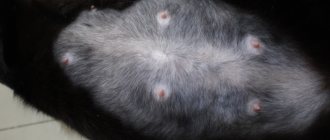If the owners notice swelling or blood from the ear of their pet, they need to contact a veterinarian. A tumor in a cat’s ear can be benign or malignant, and in the latter case, without timely treatment, there is a high probability of death. With the neoplasm, the kitten and adult also experience small pimples, peeling of the skin is possible and the hairs in the area of the damaged ear become light.
What is it connected with: the main reasons
A tumor behind a cat’s ear does not always indicate a pathological process. Sometimes a purulent lump or hematoma is a consequence of mechanical damage to the auricle. Swelling and hardening can also occur when a cat has a pimple in the ear canal. Other factors can also influence the violation:
- dermatological disease;
- benign neoplasms;
- hormonal imbalance in the cat’s body;
- inflammatory reaction in the ears;
- malignant tumors of the external auditory canal.
Oral diseases
If a cat has a formation on its face and the eye is festering, it may be due to a dental disease. Problems in the oral cavity can cause enlargement of surrounding tissues.
What diseases can lead to the formation of a swelling on the cheek?
- Flux . This is an infectious disease. Suppuration occurs in the periosteum and in the tooth. A lump with purulent contents forms. If the process is started, it can spread to neighboring tissues. Subsequently, a fistula forms and pus flows out of the resulting hole. If it lasts for a long time, the ears and eyes can fester.
- Gum disease . Oral infections can lead to various inflammations in the gums.
- Stomatitis . A painful ulcer appears in the mouth. Due to swelling and inflammation, the cat will not be able to open its mouth wide and eat.
Each of these diseases is painful. In order not to torment the animal, it is better to give it painkillers. It is necessary to contact a veterinarian as soon as possible. Prolonged illness will lead to tissue necrosis and jaw deformation. The cat will not be able to eat normally and will become very thin.
Types and clinical symptoms
Neoplasms: do they pose a threat?
Various tumors can form on a cat’s ears, which differ in malignant or benign nature. This lump is more often formed in older individuals. Ceruminoma, which affects the sulfur glands of the animal, is more common. The cancer grows rapidly and is fatal. Oncology can be recognized by the following symptoms:
A cancerous tumor differs in its growth rate and is accompanied by symptoms such as discharge from the ear canal.
- the formation of multiple small nodules on the ear;
- addition of infection;
- constant scratching of the cat's ear;
- unpleasant discharge from the ear canal.
Among the most common benign tumors, veterinarians highlight ear atheroma, which is a cystic formation in the sebaceous gland. Such a lump can be removed surgically.
Acne associated with dermatitis
The appearance of flaking, multiple pimples and bumps on a cat’s ears are a consequence of a dermatological disease. Such acne appears due to helminth infection and under the influence of other factors. If you don’t notice the problem in your cat’s ears in time, then soon crusts will form near the ear canal and weeping ulcers. The following symptoms are typical for acne:
- severe itching sensations;
- accumulation of secretions in the ear canal that have an unpleasant odor;
- redness of the skin near the sore ear;
- hearing problems.
Parasite activity
Infection with scabies mites is indicated by severe itching and a strong odor from the ear.
If a tumor appears in the cat's ear area, then it is worth examining the pet for the presence of scabies mites. When infected with such a parasite, the pet develops otodectosis. The main food for the parasite is epithelial tissue and blood. If there is a violation, the animal not only develops a tumor, but also other symptoms:
- severe itching;
- copious discharge of brown color and loose consistency;
- pungent odor from the ear.
Other varieties
A tumor can occur in a cat with the following abnormalities:
- Necrotic process. Occurs against the background of infection, mechanical damage or purulent-inflammatory reaction. Pets that live outside for a long time during the cold season are prone to pathology.
- Hematoma. This type of tumor appears after an insect bite, scratching, or injury to the ear. It is also accompanied by pain and redness.
- Inflammatory reaction. In veterinary medicine, this disorder is called otitis media, which is characterized by itching and profuse discharge.
- Lymphoextravasate. Accompanied by impaired accumulation of lymphatic fluid under the skin of the auricle. It is characterized by slow progression, while the affected area turns red and becomes hot.
Veterinarians recommend regularly examining cats' ears for ulcerative formations that occur due to fungal infection. For such tumors, self-medication is prohibited, especially with the use of ointments.
The main reasons for the appearance of a lump behind a cat's ear
The most common reason is cat fights.
With the onset of spring, many cats get into fights to attract the attention of the opposite sex or to establish the boundaries of their territory. As a result, combatants have lacerated ears, claw wounds, and swelling on the face or ears.
If your pet does not walk outside, diseases can lead to tumors behind the ears. Among them are both dangerous and easily treatable.
Abscess
Translated from Latin, it literally means “abscess.” This is an inflammatory disease in which a cavity is formed filled with purulent contents. The formation of a lump leads to the development of a deep abscess. In this case, muscle tissue and subcutaneous fat are affected. Among the main signs of the disease are:
- Redness . Its appearance indicates that an inflammatory process has begun in the animal’s body.
- Edema . The lesion begins to rise above the surface of the skin and increases in size.
- Fluctuation (filling with pus) . This stage is characterized by the presence of purulent contents. On palpation, it flows from one edge of the cavity to the other.
Consequences. With good immunity in the mustachioed-striped, the disease most often ends in an outpouring of pus. In more severe cases, gangrene or phlegmon may begin to develop.
Therapy. All treatment boils down to opening the abscess and removing the pus. In more severe cases, surgical excision of necrotic tissue is performed. After opening, the abscess is washed with antiseptic solutions, drainage is installed in the wound and stitches are applied. Subsequent treatment is with antibiotics and continues for a week.
Phlegmon
It can be either an independent disease or a complication of an abscess or carbuncle. Most often caused by Staphylococcus aureus and characterized by putrefactive or purulent inflammation of fatty tissue. The difference between phlegmon and other inflammatory processes is the absence of clear boundaries.
Therapy. Treatment is carried out by opening and removing the contents. After cleansing the cavity, apply a bandage to the wound using fatty ointments:
- Vaselinova;
- Vishnevsky;
- Sintomycinova;
- Tetracycline.
If there are signs of necrosis (tissue death), necrolytic agents (for example, trypsin) or enzyme-containing ointments are prescribed to accelerate the process of rejection of the affected tissue.
Otodectosis
The disease is caused by tiny parasitic insects.
When infected with ear mites, the animal begins to shake its head and scratch its ears.
If an infection gets into the wounds, swelling soon begins and an abscess or phlegmon develops. Otodectosis often ends in death. Treatment should primarily be aimed at combating the ear parasite. After recovery, the lump on the ear can be removed surgically.
Enlarged lymph nodes
Compaction and enlargement of lymph nodes are typical for:
- Lymphadenitis, which is caused by various viruses and bacteria.
- Malignant neoplasms that metastasize to the lymph nodes.
Lymphadenitis is characterized by high fever, apathy and decreased appetite. But the disease is not so dangerous, and after eliminating the cause of inflammation, the lymph nodes return to their previous size.
Diagnostic procedures
A complete examination of your pet, for which you need to donate blood for analysis, will help you make a diagnosis.
A tumor on a cat’s ear requires contacting a veterinarian, since it can pose a danger not only to the health, but also to the life of the animal. First, the specialist examines the damaged area of the pet and asks the owner about possible injuries and mechanical damage. To make a final diagnosis and select treatment, the following diagnostic procedures are performed:
- blood and urine tests;
- laboratory examination of ear discharge;
- biopsy to determine the nature of the tumor.
Abscess
The cause of suppuration is dirt brought in by an opponent during a fight due to weakened immunity. Most often, the lump forms behind the ear or directly under it, where the soft tissue is located.
In most cases, the abscess breaks out on its own, the pus flows out and a scar forms. The wound can be treated with an antiseptic wound-healing spray, but not with iodine tincture or brilliant green solution, which burn. If the cat is lethargic, refuses to eat, the abscess does not break out, or increases in size, seek veterinary help.
Possible treatments
Therapy for each cat is selected individually depending on the diagnostic results and the severity of the tumor in the ear. During treatment procedures, it is necessary to treat the affected area with antiseptic solutions several times daily. In case of an inflammatory reaction or minor damage, medications of the following groups are used:
- antibiotics;
- anti-inflammatory;
- painkillers;
- immunostimulating.
If the tumor is benign, then it is surgically removed. During the postoperative period, the cat needs to take medications for a speedy recovery. When the tumor is oncological in nature, chemotherapy is first performed, followed by surgery to remove the tumor in the ear area. The earlier cancer is detected, the greater the chances of curing it. In advanced forms, when cancer cells have spread to other lymph nodes and internal organs, treatment is ineffective and the cat must be euthanized.
Hematoma
Hematoma on the inner surface of the ear
A hematoma is a cavity filled with blood. The auricle is devoid of fatty tissue and poor in muscle, so the contents of damaged vessels lead to the formation of a cavity between the cartilage and the skin.
There are combat hematomas, which pets get during fights, and pathological ones, caused by a blood clotting disorder. Predisposing factors are old age and accompanying chronic illnesses. Another reason is systemic hematopoietic diseases. In this case, hematomas occur as a result of scratching due to itching due to flea bites, diabetes, and allergic reactions. Fragile vessels are destroyed when scratched, and blood flows under the skin.
The skin at the site of the formed lump is first red and hot, then darkens and cools. If the pathological cavity is small and does not cause inconvenience, it slowly resolves. When the swollen ear droops, the head tilts towards the damaged shell. The animal tries to scratch the bump and shakes its head.
The diagnosis is made by clinical examination. If there is a suspicion of the secondary nature of the pathological condition, a biochemical blood test is performed. If an underlying disease is detected, it is treated. Conservative treatment of the hematoma itself is ineffective. Surgical treatment consists of opening the cavity, removing the contents and sanitizing with antiseptic solutions.
Be sure to read:
How to understand that a cat is sick: external signs, how the animal behaves, clear signs of illness, what to do
The operation is performed under general anesthesia. To prevent the formation of rough scars, a method with a hemostatic sponge is used. While the wound is healing, an Elizabethan collar is put on the pet.
Ixodid tick
Ixodid tick
Sometimes an ixodid tick that has burrowed into an ear or another part of the body and sucked blood is mistaken for a lump.
Ticks are brought home by cats traveling through areas rich in bushes. Arthropods most often attack in early spring.
Ticks can carry the following infectious diseases:
- Borreliosis or Weill's disease - bacteria lead to refusal to eat, dermatitis, and heart problems. Lymph nodes enlarge. After 2 months, lameness develops.
- Hemobartonellosis: rickettsia, which are activated under the influence of stress and consumption of large amounts of raw river fish. Anemia develops - urine becomes thin, mucous membranes become pale.
If the arthropod is torn off, severe inflammation will develop. Therefore, a responsible owner of a roaming cat purchases a tick remover and carefully removes the parasite. You should work carefully: if you crush a tick, its contents will fall on your hands. Parasites transmit infectious diseases of cats, dogs and humans.
Unscrewing the pliers
Reliable protection - Spot-on drops that protect against ticks, fleas and worms. The parasite should be placed in a bottle and taken to the laboratory. If pathogens are detected, early treatment will avoid consequences.










